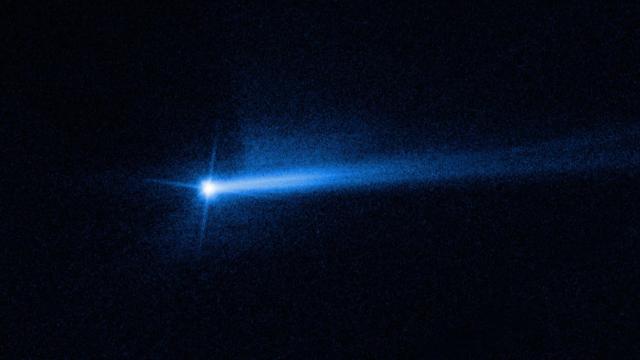A new image from the Hubble Space Telescope shows a pair of dusty tails extending out from Didymos-Dimorphos, the result of NASA’s DART spacecraft smashing into the smaller member of the binary asteroid system.
One tail, sure. But two? That’s undeniably weird, and also awesome. The European Space Agency posted the newly acquired image earlier today, revealing the complex aftereffects of NASA’s $US308 ($428) million experiment to nudge a harmless asteroid.
Indeed, NASA’s Double Asteroid Redirection Test, or DART, has been an astounding success, but astronomers are seeing things they’ve never encountered before. I suppose that’s to be expected when you fling a 608 kg probe into an asteroid at speeds reaching 22,531 km per hour. The impact reduced Dimorphos’s orbital period around Didymos by a whopping 32 minutes, which amounts to several dozen feet in terms of the asteroid’s total inward movement. It’s one small shove for a spacecraft but a giant leap in terms of our eventual ability to re-organise the solar system in beneficial ways.
See more on this story: How DART scientists know the experiment to shove an asteroid actually worked
Hubble has been observing the Didymos-Dimorphos system since the experiment took place on September 27, collecting 18 images in the days following the impact. A dusty tail formed quickly as a result of the celestial collision, but observations performed by Hubble between October 2 and 8 revealed not one but two tails sprouting out from the system, located nearly 7 million miles away.
DART churned up a lot of dust when it impacted the rubble pile asteroid, creating a series of tentacle-like plumes and a sphere of dust and debris in the immediate vicinity of the binary pair. The appearance of the northern, or upper, second tail is a recent development.
“The relationship between the comet-like tail and other ejecta features seen at various times in images from Hubble and other telescopes is still unclear, and is something the Investigation Team is currently working to understand,” ESA wrote. “In the coming months, scientists will be taking a closer look at the data from Hubble to determine how the second tail developed.”
To be clear, the dusty tail is not trailing behind the orbiting asteroid. Rather, it’s the result of solar winds blowing the fine-grained particles away from Dimorphos. Hubble will continue to investigate the crash scene to further document this historic test, which could eventually result in a robust planetary defence system against hazardous asteroids.
